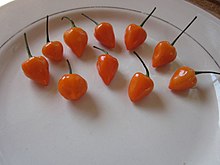| 'Kambuzi' | |
|---|---|
 | |
| Genus | Capsicum |
| Species | Capsicum chinense [1] |
| Cultivar | 'Kambuzi' |
| Origin | Malawi |
| Heat | |
| Scoville scale | 50,000–175,000 [2] SHU |
Kambuzi is a small, round chili pepper cultivar found in central Malawi, a landlocked country in southeast Africa. It comes in a variety of colors including yellow, red and orange. It is used to make condiments and turned into sauces, or sandwich spreads. [3] [4] [5] Their flavor is similar to that of the Habanero chili.
The name translates to "little goat", as goats are known to munch on the leaves of these peppers. [6]